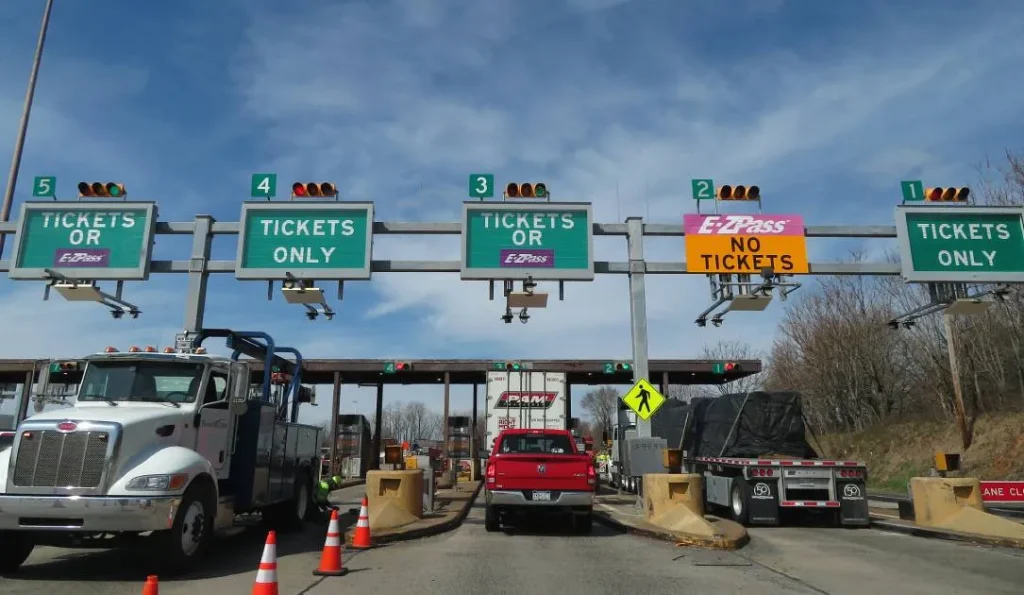In recent months, an alarming number of New York E-ZPass users have reported falling victim to a text message scam. According to the FBI, over 2,000 scam complaints have been received, with many drivers losing access to their personal and financial information. This scam targets everyday drivers who use E-ZPass for toll payments, tricking them into believing they owe money when, in fact, the messages are fraudulent.
What Is the E-ZPass Scam?
The scam involves fake text messages that look like they come from official E-ZPass or Tolls By Mail communications. These texts claim that the recipient has an unpaid toll and urge them to take immediate action. They often include links that, when clicked, prompt users to enter sensitive personal details, such as credit card numbers, Social Security numbers, and other identifying information. Once scammers obtain this data, they can use it to commit identity theft and financial fraud.
The E-ZPass Group and New York State officials have warned the public about this scam. New York Senator Patricia Canzoneri-Fitzpatrick posted on Facebook, stating:
“The NYS Thruway Authority has seen an uptick in phishing text scams regarding E-ZPass and Tolls By Mail. Real communications WILL ONLY refer customers to these official websites: e-zpass.com or tollsbymailny.com.”
This message is critical because it helps distinguish between legitimate and fraudulent communications. Real messages from E-ZPass will direct you only to the official websites, and they will never ask you to provide sensitive information via text message or email.
How the Scam Works
Scammers send out text messages that mimic official notifications from the NYS Thruway Authority. These messages appear genuine at first glance. They often include details such as a supposed toll amount or a warning of potential consequences if the toll is not paid promptly. The urgency in these messages is designed to force the recipient to act quickly without double-checking the source.
For example, a fake text might read:
“URGENT: You owe $25 in unpaid tolls. Pay immediately at tollsbymailny.com or face penalties.”
In contrast, an authentic E-ZPass text would only direct you to the official website, such as:
“Please visit e-zpass.com for your account details. We will not ask for sensitive information via text.”
This clever mimicry makes it difficult for some drivers to tell the difference, especially if they are not well-informed about the proper channels of communication. Many fall victim to the scam because they are unaware that real messages from the Thruway Authority have a very specific format and only direct users to secure, official websites.
Why New York Is a Prime Target
New York has one of the busiest toll systems in the country, with millions of drivers using E-ZPass every day. This makes it an attractive target for scammers looking to harvest personal and financial data. The sheer volume of users increases the likelihood that even a small percentage of successful scams can result in a significant number of complaints and substantial financial losses.
Furthermore, the constant evolution of phishing techniques means that scammers are continually refining their methods to appear more credible. They exploit the trust that drivers place in official-looking communications, making it even harder for the average person to spot a scam.
Real and Fake Text Examples
To help you distinguish between real and fake E-ZPass communications, here are some examples:
Fake Text Example 1:
“ALERT: Your account has an overdue balance of $18.00. Pay now at tollsbymailny.com to avoid service interruption.”
Fake Text Example 2:
“NOTICE: Unpaid toll fees detected. Click the link below to clear your balance immediately: [link]”
Real Text Example:
“STAY ALERT. We continue to receive reports about a smishing scam. E-ZPass or Tolls By Mail WILL NEVER send a text or email requesting sensitive personal information such as credit card numbers, Social Security, usernames, or passwords. For assistance, please visit e-zpass.com.”
As you can see, real messages are straightforward and direct you to trusted websites. They do not include urgent warnings or direct links asking you to input sensitive data.
What to Do If You Receive a Scam Message
If you receive a text message that claims you owe tolls and includes a link or asks for personal information, take the following steps:
- Do Not Click on the Link:
Avoid clicking any links in the message. These links may lead to fake websites designed to steal your information. - Do Not Reply or Provide Information:
Do not respond to the message or provide any personal or financial details. Scammers use these responses to gain further access to your accounts. - Verify the Message:
Go directly to the official E-ZPass website (e-zpass.com) or the Tolls By Mail website (tollsbymailny.com) to check your account status. Do not use the link provided in the text. - Contact Customer Service:
If you are unsure about the legitimacy of a message, call E-ZPass customer service using the number listed on their official website. This can help you confirm whether you owe any tolls. - Report the Scam:
File a complaint with the Federal Trade Commission (FTC) if you receive a suspicious message. Reporting these scams helps authorities track and shut down fraudulent operations.
The Role of Social Media and Public Awareness
Social media platforms play a critical role in both spreading and combating these scams. While scammers often use social media to spread false information and create panic, public officials and consumer protection agencies use the same platforms to warn and educate the public.
For instance, New York Senator Patricia Canzoneri-Fitzpatrick has been active on Facebook, urging drivers to be cautious and to verify any communications they receive about E-ZPass tolls. The FBI has also issued warnings and guidelines on how to recognize and avoid phishing scams.
Public awareness campaigns are essential in reducing the number of scam victims. When drivers know what to look for, they are less likely to fall for these tricks. Educational posts, videos, and community alerts help spread the word quickly and effectively.
The Growing Trend of Phishing and Smishing Scams
This scam is part of a broader trend known as “smishing,” which is a type of phishing that uses text messages instead of emails. Scammers target mobile phone users by sending texts that appear to come from trusted sources. These messages often contain urgent language to prompt immediate action, making it difficult for recipients to think carefully about the request.
The FBI has noted an increase in smishing scams in recent months, affecting various sectors, including transportation and financial services. With over 2,000 complaints related to E-ZPass scams alone, it is clear that these tactics are becoming more sophisticated and widespread.
Protecting Your Personal Information
In today’s digital age, protecting your personal and financial information is more important than ever. Scammers are constantly developing new methods to trick individuals into giving away sensitive data. Here are some general tips to keep your information safe:
- Be Skeptical:
Always be cautious of unsolicited text messages, emails, or phone calls asking for personal information. If something seems off, verify it through official channels. - Update Your Security:
Use strong, unique passwords for your online accounts and enable two-factor authentication where possible. Regularly update your device’s software to protect against security vulnerabilities. - Monitor Your Accounts:
Regularly check your bank and credit card statements for any unauthorized transactions. Early detection of suspicious activity can help minimize potential losses. - Educate Yourself:
Stay informed about the latest scams by following news from reliable sources such as the FTC and local law enforcement agencies. Knowledge is your best defense against fraud.
The Broader Impact of These Scams
The E-ZPass scam not only affects individual drivers but also has broader implications for public trust and financial security. When scams like these are successful, they erode confidence in digital communications and government agencies. Drivers may become wary of legitimate messages, which can hinder the effectiveness of important notifications from official sources.
Moreover, the financial losses from these scams can add up quickly. When large numbers of people fall for fraudulent messages, the resulting losses can run into millions of dollars. This money, lost to scammers, could have been used for more productive purposes within the community.
Conclusion
The rise of E-ZPass scams in New York is a clear reminder of the importance of vigilance in today’s digital world. With over 2,000 scam complaints reported by the FBI, it is crucial that all E-ZPass users remain cautious and take proactive steps to protect their personal information. By understanding what a genuine E-ZPass message looks like and knowing how to verify any claims through official channels, drivers can avoid falling victim to these frauds.
Always remember: genuine communications from the NYS Thruway Authority will only direct you to the official websites—e-zpass.com and tollsbymailny.com. Do not click on any links or provide sensitive information in response to unsolicited texts. If in doubt, contact customer service directly and report any suspicious messages to the Federal Trade Commission.
As scams continue to evolve, public awareness and education become more critical than ever. By sharing accurate information and following simple security practices, we can all help reduce the risk of falling prey to these fraudulent schemes. Protecting your financial information is a shared responsibility—stay informed, stay cautious, and help spread the word so that others can be safe too.
Disclaimer – Our editorial team has thoroughly fact-checked this article to ensure its accuracy and eliminate any potential misinformation. We are dedicated to upholding the highest standards of integrity in our content.





More Stories
Learn How to Spot and Avoid the E-ZPass Scam That’s Tricking Thousands
Learn How to Spot and Avoid the E-ZPass Scam That’s Tricking Thousands
Learn How to Spot and Avoid the E-ZPass Scam That’s Tricking Thousands